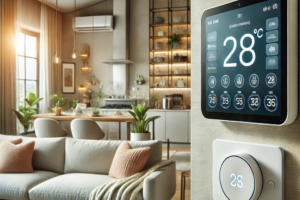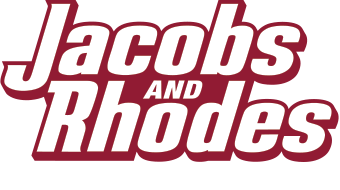Choosing the Best Thermostat for Your HVAC System
 Did you know that the thermostat you choose can significantly impact how efficiently your HVAC system operates? Jacobs and Rhodes, understands selecting the right thermostat can be a daunting task, given the wide range of options available in today’s market. This guide will help you navigate through the different types of thermostats, their features, and what to consider when choosing the best one for your home.
Did you know that the thermostat you choose can significantly impact how efficiently your HVAC system operates? Jacobs and Rhodes, understands selecting the right thermostat can be a daunting task, given the wide range of options available in today’s market. This guide will help you navigate through the different types of thermostats, their features, and what to consider when choosing the best one for your home.
Why the Right Thermostat Matters
A thermostat is more than just a device that controls your home’s temperature. It’s the interface between you and your HVAC system, dictating how and when your heating and cooling equipment operates. The right thermostat can lead to improved energy efficiency, lower utility bills, and enhanced comfort levels. Conversely, an outdated or improperly chosen thermostat can result in inconsistent temperatures, higher energy consumption, and increased wear and tear on your HVAC system.
Types of Thermostats
1. Manual Thermostats
Manual thermostats, also known as mechanical or analog thermostats, are the most basic type of thermostat. They require you to manually adjust the temperature setting. While they are straightforward and inexpensive, they lack the advanced features of modern thermostats, such as programmable settings and remote control. Manual thermostats are best suited for those who prefer simplicity and are home frequently to adjust the temperature as needed.
2. Programmable Thermostats
Programmable thermostats allow you to set a schedule for your HVAC system. You can program different temperatures for various times of the day and days of the week. For example, you can set the thermostat to lower the temperature while you are at work and raise it just before you return home. This feature helps to optimize energy use and reduce costs. Programmable thermostats are ideal for households with a regular routine.
3. Smart Thermostats
Smart thermostats represent the cutting edge of thermostat technology. They connect to your home Wi-Fi network, allowing you to control your HVAC system remotely via a smartphone app. Smart thermostats can learn your schedule and preferences, adjust settings automatically, and provide energy usage reports. Many models also integrate with smart home systems like Amazon Alexa and Google Home. Although smart thermostats are more expensive, their advanced features and energy-saving potential make them a popular choice among tech-savvy homeowners.
4. Wireless Thermostats
Wireless thermostats function similarly to smart thermostats but offer more flexibility in placement. They don’t need to be hardwired to your HVAC system, making them an excellent option for homes where traditional thermostat placement is inconvenient or impossible. Wireless thermostats often come with sensors that you can place in different rooms to monitor and control the temperature more accurately throughout your home.
Key Features to Consider
When choosing a thermostat, it’s important to consider the following features to ensure it meets your needs and preferences:
1. Compatibility with Your HVAC System
Not all thermostats are compatible with every HVAC system. Check whether the thermostat you are considering works with your specific heating and cooling setup. Some thermostats are designed for single-stage systems, while others are compatible with multi-stage or heat pump systems.
2. Ease of Use
The user interface and ease of programming are critical factors. Look for a thermostat with a clear display and intuitive controls. Smart thermostats with touchscreen interfaces or voice control can simplify the operation even further.
3. Energy-Saving Features
Consider thermostats with features like geofencing, which adjusts the temperature based on your proximity to home, or adaptive learning, which learns your schedule and adjusts settings automatically. These features can significantly enhance energy efficiency.
4. Remote Access
If you want the convenience of adjusting your home’s temperature from anywhere, choose a thermostat with remote access capabilities. This feature is particularly useful for those with unpredictable schedules.
5. Zoning Capability
For larger homes or homes with multiple HVAC zones, a thermostat with zoning capability can control different areas independently. This allows for more precise temperature management and can improve overall comfort and efficiency.
6. Integration with Smart Home Systems
If you have a smart home setup, consider a thermostat that integrates with your existing system. This allows you to control the thermostat using voice commands or through your smart home hub.
Installation Considerations
Installing a thermostat can be a DIY project, but it’s crucial to ensure proper installation to avoid issues with your HVAC system. Here are some tips:
- Turn Off Power: Always turn off the power to your HVAC system before starting the installation to avoid electrical hazards.
- Follow Instructions: Carefully follow the manufacturer’s installation instructions. Each thermostat model may have specific requirements.
- Check Wiring: Ensure that the wiring is correct. Most thermostats come with a wiring guide, but if you’re unsure, it’s best to consult a professional.
- Test the System: After installation, test your HVAC system to ensure the thermostat is functioning correctly.
Conclusion
Whether you opt for a manual, programmable, smart, or wireless thermostat, consider your specific needs, lifestyle, and budget.
At Jacobs and Rhodes, we’re here to help you make an informed decision and provide expert installation services if needed. Investing in the right thermostat can lead to a more comfortable home environment and savings on your energy bills.
If you have any questions or need assistance, don’t hesitate to contact us. We’re always ready to help you achieve the perfect indoor climate.

 Jacobs and Rhodes
Jacobs and Rhodes Jacobs and Rhodes
Jacobs and Rhodes